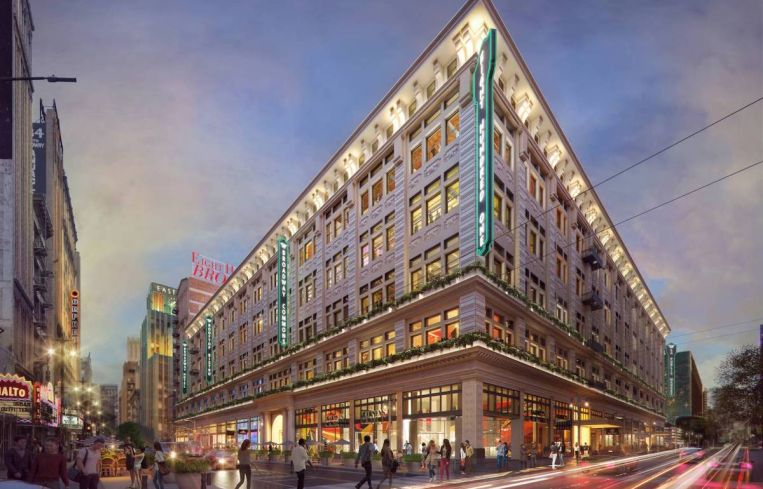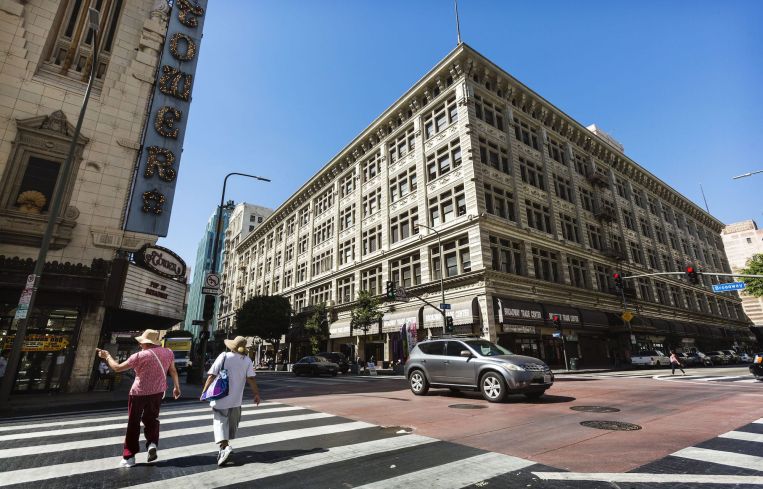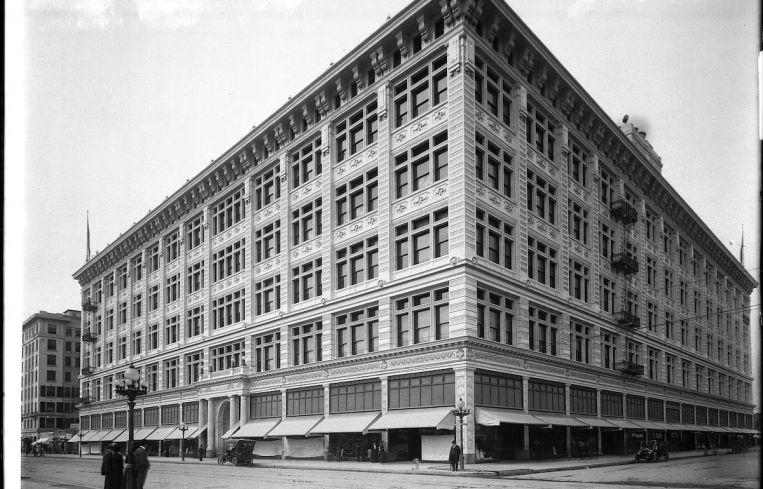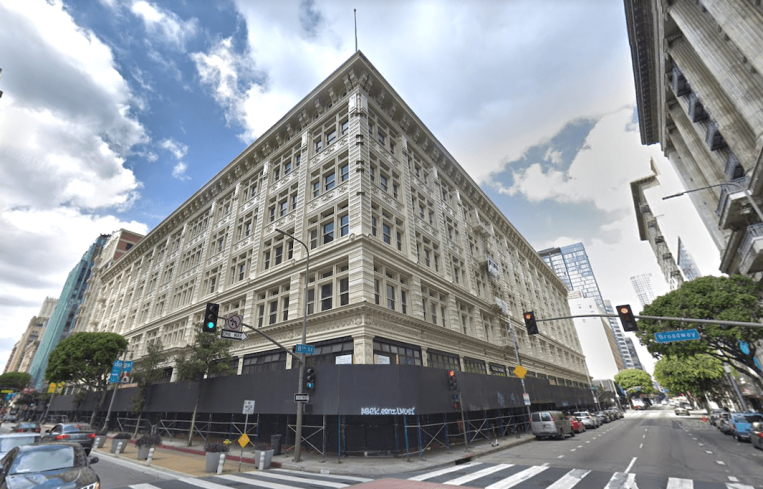Starwood Extends Loan to Year-End on Massive DTLA Project: Updated
The Broadway Trade Center redevelopment includes 624,500 square feet of office, 345,000 square feet of retail and 150 boutique hotel rooms
By Greg Cornfield April 22, 2021 8:05 am
reprints




UPDATE: Time has tested the historic Broadway Trade Center — a vacant, 1.1 million-square-foot structure in Downtown Los Angeles that was first completed in 1908.
It was once the largest department store west of the Mississippi River and a crown jewel of Southern California. But after decades of decline and a global pandemic, the fate of the historic landmark, as well as the massive redevelopment plan to bring it back to life, will surely be emblematic of Downtown L.A.’s future.
The building’s owners, Broadbridge LLC — a joint venture of Continental Equities and Waterbridge Capital — told Commercial Observer that Starwood Property Trust agreed to extend funding for the development to the end of the year. Sources familiar with the agreement confirmed the extension and said the financing amount is unchanged, and that the loan is “in good standing.” The owners declined to share additional details on the financing.
An affiliate of Starwood first provided a $213 million financing in mid-2018 with a term of 18 months, as CO reported. When that came due in December 2019, Starwood signed off on a $218.7 million modification, and is now extending that debt, according to sources familiar with the deal.
Starwood did not return requests for comment.
The extension buys more time for the project at 801 South Broadway, which is the largest office project under construction in L.A., and the sixth-largest office project set to be completed this year in the country. With frontage on Eighth Street, Hill Street and Broadway, the project calls for 624,500 square feet of office, 345,000 square feet of retail and 150 boutique hotel rooms, according to the Downtown Center Business Improvement District (DCBID). The owners picked up the property in August 2014 for $122.3 million.
Nick Griffin, executive director of the DCBID, said the project is “far and away” the most important in the Historic Core and for Broadway in general.
“The mix of uses would be really transformative for that area,” he said.
The project was brought into question when a report surfaced last week stating that a foreclosure sale was scheduled for the 2.7-acre property that covers half a city block. (The report has since been updated to state the foreclosure was resolved). Representatives for Broadbridge said the issue stemmed from a misunderstanding with a minority equity partner selling their share, but that has since been resolved, and “the notice of foreclosure has been withdrawn.”
Continental Equities told CO that they are moving forward with the redevelopment with massive office and retail space. The joint venture has also been parallel-processing strategies: looking to both sell the property and secure entitlements for the ambitious transformation. Past off-market listings show Broadbridge has asked $425 million.
Now, projects that bring people together in so many ways face a new kind of test after a year when people were told to stay away from each other. Starwood and Broadbridge are betting their project won’t be another casualty to the downturn like U.S. Bank Tower — the most recognizable building in L.A.’s skyline — which sold last summer to Silverstein Properties at a massive 31 percent discount to its 2019 valuation. The pandemic price cut was reached after taking into account “U.S. property market conditions” and because “tenants in the property have reduced, or temporarily closed down, their operations, and the rental income from the property has been correspondingly affected,” according to sellers OUE Limited.
Broadbridge is also betting it won’t go the way of the $1 billion Oceanwide Plaza, another mixed-use development nearby, where work stopped mid-construction more than a year ago, and cranes remain frozen in time.
Office space has struggled with high vacancy rates for decades, and that problem has grown under pandemic conditions. The amount of available space — the sum of sublease space and vacant space — in Downtown L.A. is up to 27.7 percent, according to Savills’ first-quarter office report. And, perhaps worse, the Broadway corridor, located in the Historic Core submarket with the Broadway Trade Center, includes some of the most underutilized historic buildings in the nation.
However, Broadbridge’s development follows a years-long multifamily and hotel boom downtown, from the Arts District neighborhood to South Park and up the Grand Avenue corridor. Major investment over the past 20 years led to the creation of L.A. LIVE and significant revitalization up to the Walt Disney Concert Hall, where another major test is playing out: the $1 billion mixed-use development called The Grand by Related Companies — some 17 years in the making. It receives most of the fanfare due to its location, size, and the fact that it was designed by the city’s favorite architect, Frank Gehry. And Griffin said The Grand transforms its immediate area by connecting Bunker Hill with the Civic Center area with the arts and culture destinations.
“This Broadway Trade Center project does the same sort of thing,” he said. “It’s a center of gravity that everyone will orient around. When that project happens, then the rest of the properties on Broadway will go like dominoes.”
The Historic Core is already seeing its own signs of hope after a surge in adaptive reuse projects. For example, work has started on the new Apple Store across the street at the historic Tower Theater at 8th and Broadway, according to the DCBID. Urban Offerings is also building 140,000 square feet at the Dearden’s Building. Across the street from the Broadway Trade Center, Beverly Hills-based Markwood is working on an adaptive reuse project, converting the historic May Company Garage into a modern office space.
Griffin also pointed to Vans, Paul Smith, Jordan Brand and other newcomers lining the corridor up to the Grand Central Market.
“The project brings a critical mass of retail and restaurants to Broadway, which is already teed up to be a truly amazing retail corridor,” he said. “Retail is on its heels right now, but there’s a sense that an urban destination like this is different.
“Eighth Street itself is shaping up to be a dynamic corridor, and when you have an axis of those streets, it can have a transformative effect bringing together that mix of activities.”
The Broadway Trade Center is a registered Historic-Cultural Monument, first opening as the Hamburger & Sons Department Store. It was later acquired by the now-defunct May Company, which was one of the most well-known landlords in the region for decades. The building was transformed into the Broadway Trade Center about 30 years ago, and operated as a mixed-use garment manufacturing building until its most recent acquisition. They removed 267 garment tenants that were under month-to-month leases, demolished the full interior, and restored the facade.
UPDATE: This story has been updated since publication to include comments from Nick Griffin of the DCBID.



